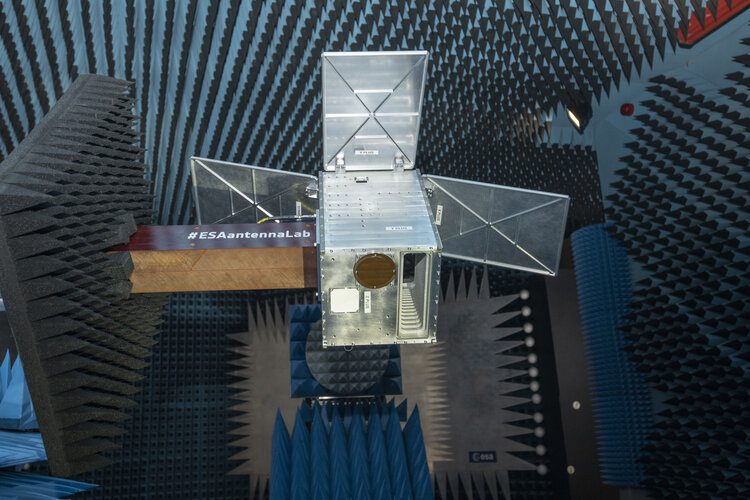This satellite mockup, seen during antenna testing, shows the shape of ESA’s new Proba-V Companion CubeSat, which is due for launch at the end of this year.
The mission is a 12-unit ‘CubeSat’ – a small, low-cost satellite built up from standardised 10-cm boxes. It will fly a cut-down version of the vegetation-monitoring instrument aboard the Earth-observing Proba-V to perform experimental combined observations with its predecessor.
A pair of antennas for the CubeSat, mounted in this ‘structural and thermal model’ underwent testing at ESA’s Compact Antenna Test Range at the ESTEC technical centre in the Netherlands.
“The white patch is a directional high-data rate antenna, needed to downlink large amounts of imagery to users,” explains Xavier Collaud of Aerospacelab in Belgium, developing the mission for ESA. “Then the brown patch is an omnidirectional antenna, that – combined with a similar antenna on the other side – allows the reception and transmission of lower-data rate signals in any direction, enabling the control of the mission.
“These antennnas are commercial off the shelf equipment, allowing the building up of small satellites in an affordable, modular manner. They are supplied by Syrlinks, in partnership with ANYWAVES, both in France.
“Testing the antennas in the fully controlled environment of ESA’s CATR gives us the sensitivity we need for top-quality results. We’ve been testing with the antennas mounted within this satellite model because its structure influences the antenna radiation – so for instance we’ve been measuring the signal patterns and strength with the solar panels stowed as well as deployed, to make sure we can communicate with the CubeSat in that configuration.”
Launched in 2013, Proba-V was an innovative a ‘gap filler’ mission between the Vegetation instruments monitoring global plant growth aboard the full-size Spot-4 and -5 satellites and compatible imagery coming from Copernicus Sentinel-3, the first of which flew in 2016.
By combining the views from three adjacent telescopes into one, Proba-V’s Vegetation achieved a continent-spanning swath of 2250 km, allowing to image the entire world’s plant growth in just over a day. But with its operational mission now over, Proba-V has shifted to experimental mode.
As part of that effort, the Proba-V Companion CubeSat will host a single telescope version of the Vegetation imager, left over from Proba-V development. The two missions will perform joint observations, to evaluate how well the instrument performs on a smaller, lower-cost platform.
Aerospacelab will also gain operational experience to be applied to its planned constellation of geospatial-information-gathering small satellites.
“The antenna test campaign took about two weeks,” adds ESA antenna engineer Eric Van Der Houwen. “We obtained spherical near-field patterns of the antennas, both individually and in combination, to measure how much they radiate and in which directions, having begun with a reference antenna in order to determine our setup was optimal.”
Based on the antenna test results, as well as mechanical testing performed with another CubeSat model, the Proba-V Companion CubeSat mission has now entered its detailed qualification and production ‘Phase D’, on track for launch this year. The mission is supported through the Fly in-orbit testing element of ESA’s General Support Technology Programme.
#ESAAntennaLab



 Image:
Proba-V’s plus one
Image:
Proba-V’s plus one